India and China are among the oldest civilisations on the planet Earth and have had one of the longest uninterrupted existence as states in the world history. The cultural, religious and trade links between these two countries are centuries old. Intellectual and scholarly interactions between the Indian and Chinese pilgrims and travellers (Faxian, Xuanzang, l-tsing) laid a strong foundation of understanding between these two great civilizations.
Even in the modern history of the world, India and China have emerged as independent nation-states around the same time. India became independent in 1947, and China took birth as a Communist State in 1949. However, India-China relations have experienced deep fluctuations over the past seven decades, ranging from ‘compassionate camaraderie 1 in the 1950s to armed conflict in the 1960s, and strategic distance in the 1970s to efforts for normalisation in 1980s. Since the end of the Cold War in early 1990s, however, the two Asian giants have been searching for a new relationship based on conflict resolution, confidence building measures and cooperative arrangements.
Sino-lndia Relations: A Timeline
| Timeline | Key Event |
|---|---|
| 30 December 1949 | India became the second non-communist nation to recognize the Peoples’ Republic of China after its proclamation on 1 October 1949. |
| May 1951 | China forced the Tibetan Governor of Chamdo to concede full suzerainty over Tibet. |
| 15 May 1954 | China and India signed the Panchsheel document. Panchsheel Principles: Mutual respect for each other’s territorial integrity and sovereignty. Mutual non-aggression. Mutual non-interference in each other’s internal affairs. Equality and cooperation for mutual benefit. Peaceful co-existence. |
| 3 April 1959 | Dalai Lama escaped from Lhasa and crossed into Indian territory. India’s decision to grant asylum to him soured relations with Beijing. |
| 1959 | China refused to accept the Me Mohan Line with Zhou Enlai stating that China was not a signatory to the 1914 Simla Accord. |
| November 1962 | A massive Chinese attack on the eastern front, Tawang, Walong in the western sector overrun, Rezang La and the Chushul airport shelled. Chinese troops captured Bomdila in the NEFA region. |
| May 1974 | China criticized India’s first peaceful nuclear explosion. |
| April 1975 | China expressed strong condemnation and utmost indignation at merger of Sikkim with the Indian Union. |
| 1986 | Beijing expressed strong condemnation over the establishment of Arunachal Pradesh as a full fledged State of the Indian Union |
| 1988 | PM Rajiv Gandhi visited China becoming the first premier to visit it after 1962 war. |
| September 1993 | Prime Minister P.V. Narasimha Rao visited China, signed agreement on Border Peace and Tranquility and the setting up of the India-China Expert Group of Diplomatic and Military Officers to assist the work in Joint Working Group. |
| 1 April 2000 | India and China commemorated 50th anniversary of their diplomatic relations. |
| 2003 | Indian Prime Minister Atal Bihari Vajpayee visited China. |
| 2006 | China and India re-opened Nathu La Pass, which was closed after the Sino-lndia war in 1962. |
| November 2010 | China started the practice of issuing stapled visas to people from Jammu and Kashmir. |
| September 2014 | Xi Jinping visited India and China promised $20 billion worth of investments in India over five years. |
| May 2017 | India declined Chinese invitation to attend the Belt and Road Initiative summit in Beijing. |
| June 2017 | India admitted to the Shanghai Cooperation Organization as full-member along with Pakistan. |
| 2018 | Chinese President held an informal meeting with Indian Prime Minister in Wuhan which set up a new model of exchanges between two leaders. Indian Prime Minister visited China to attend the SCO Summit in Qingdao. The two leaders met again on the sidelines of the 10th BRICS Summit and the G20 Summit in Buenos Aires. |
| 2019 | The second informal meeting was held in Mamallapuram, Chennai which reaffirmed the Wuhan consensus. Both nations agreed to build a closer partnership for development, enhance the in-depth strategic communication, promote mutually beneficial cooperation in various fields and advance exchanges and mutual learning between the two civilizations. Both sides met on the sidelines of the SCO Summit in Bishkek and the 11th BRICS Summit. |
| 2020 | It marks the year of the 70th anniversary of the establishment of diplomatic relations between China and India. It is also China-India Year of Cultural and People-to-People Exchanges, where the two sides agreed to hold 70 celebratory activities to demonstrate the historic connection between the two civilizations as well as their growing bilateral relationship. |
| 10 May 2020 | Chinese and Indian troops clashed in Nathu La, Sikkim. |
| 29 June 2020 | Indian government banned 59 widely used Chinese mobile phone and desktop applications in response to rising tensions and escalating diplomatic dispute between the two nations. |
| 27 October 2020 | United States and India signed the Basic Exchange and Cooperation Agreement (BECA), enabling greater information-sharing and further defense cooperation, to counter China’s growing military power in the region. |
| Dec 2022 | Indian and Chinese troops clashed in the Tawang sector of Arunachal Pradesh. |
India and China have taken different paths to development
| Political system | India is the world’s largest multi-party parliamentary democracy. | China is a one-party authoritarian rule. |
| Development Strategy in the Initial years. | India undertook the policy of closed trade. This was to give a thrust to domestic industries and reduce dependence on foreign products and companies. Thus, India followed the Import substitution strategy. | Great Leap Forward (GLF) strategy aimed at the high-scale industrialization of the economy. Rural communities were allowed to undertake collective cultivation. Urban communities were encouraged to undertake industrialization. |
| Economic reforms | Economic reforms started in 1991.India’s reforms have scaled back state-run industries drive by Liberalization, Privatization, and Globalization. | Economic reforms started in 1978.China’s reforms have created a pseudo-free-market command economy. |
| External relations | India is a masterful exponent of soft power compared to hard power. India’s best brand ambassadors are its companies, executives, academics and film stars. | The economic diplomacy approach characterizes China’s relations with the world. China is stronger than India in its common hinterland in Asia and is gaining prominence in Africa and central Asia. |
Areas of Cooperation b/w India and China
Political
On 1 April 1950, India became the first non-socialist bloc country to establish diplomatic relations with the People’s Republic of China. The then Prime Minister Nehru visited China in October 1954. While the India China border conflict in 1962 was a serious setback to the ties, Prime Minister Rajiv Gandhi’s landmark visit in 1988 began a phase of improvement in bilateral relations.
In 1993, the signing of an Agreement on the Maintenance of Peace and Tranquility along the Line of Actual Control (LAC) on the India-China Border Areas during Prime Minister Narasimha Rao’s visit reflected the growing stability and substance in bilateral ties. Summit level Visits in new millennium by Head of State/Government:
- In 2003, Prime Minister Atal Behari Vajpayee’s visit to China led to signing of a Declaration on Principles for Relations and Comprehensive Cooperation, and also mutually decided to appoint Special Representatives (SRs) to explore the framework of a boundary settlement from political perspective.
- In 2008, Indian Prime Minister Manmohan Singh visited China. Bilateral trade surpassed $50 billion, and China became India’s largest trading partner in goods.
- In 2008, two countries have also extended their strategic and military relations.
- In 2014, During Chinese President Mr. Xi Jinping to India from 17 to 19 September 2014, agreements were signed in various sectors including commerce & trade, railways, space-cooperation, pharmaceuticals, etc. The two sides also signed an MoU to open an additional route for Kailash Mansarovar Yatra through Nathu La (a pass through Sikkim).
- In 2015, Prime Minister Narendra Modi visited China, various agreements were signed including one on climate change. India also announced the extension of the e-visa facility to Chinese nationals wishing to travel to India.
- Prime Minister Narendra Modi visited China in September 2016 to participate in the G20 Summit in Hangzhou, where he also held bilateral talks with President Xi Jinping.
- President Xi Jinping visited India in October 2016 to participate in the BRICS Summit in Goa.
- The two leaders also met along the sidelines of the Sanghai cooperation Organization (SCO) Heads of States Summit in Tashkent on June 23, 2016.
- An informal summit was held between Indian Prime Minister Modi and Chinese President Xi at Wuhan in April 2018. This helped improve the relations following Doklam standoff.
Other High Level Visits and Mechanisms
- India and China have established more than thirty dialogue mechanisms at various levels, covering bilateral political, economic, consular issues as well as dialogues on international and regional issues.
- The mechanism of Special Representatives on the Boundary Question was established in 2003. The 19th round of talks between Shri Ajit Doval, National Security Advisor and Mr . Yang Jiechi, State Councillor was held in Beijing in April 2016.
- India and China have also established a High Level Dialogue Mechanism on Counter Terrorism and Security. The first meeting of the mechanism was held in Beijing in September 2016.
Economic
- India-China bilateral trade which was as low as US$ 2.92 billion in 2000, reached US$ 100 billion by 2022. India’s exports to China touched US$ 13.97 billion, whereas China’s exports were US$ 89.66 billion. Also, India faces a growing trade deficit vis-a-vis China.
- Apart from trade, India is also one of the largest markets for “project exports” from China. Currently, projects under execution are estimated at over US$63 billion. As per Chinese figures, cumulative Chinese investments into India till September 2016 stood at US$ 4.75 billion, while Indian investments into China were US$ 0.689 billion. Indian businesses have a presence in China in sectors such as IT, pharmaceuticals, and automobiles.
- With a combined market of over 2.7 billion people and a GDP of 20% of the world’s total, China and India enjoy huge potential and broad prospects for economic and trade cooperation.
Science and Technology
- Both nations have held Joint Research workshops on Science and Technology Innovation.
- Indian companies have set up IT corridors in China, which help promote China-India cooperation in information technology and high technology.
Culture and Diaspora
- India-China cultural exchanges date back to many centuries and there is some evidence that conceptual and linguistic exchanges existed in 1500-1000 B.C . between the Shang-Zhou civilization and the ancient Vedic civilization. During first, second and third centuries A.D., several Buddhist pilgrims and scholars travelled to China on the historic “silk route”.
- China was one of the co-sponsors to the UN resolution designating June 21 as the international Day of Yoga. During the visit of Prime Minister Narendra Modi to China in May 2015, a Yoga-Tai Chi performance in the world heritage site of Temple of Heaven was witnessed by Premier Li Keqiang and the Prime Minister. During the same visit, an agreement was signed to establish a Yoga College in Kunming, Yunnan Province.
- Present estimates put the Indian community strength at around 33,500. A major part of this comprises students (over 18,000), who are pursuing courses in various universities in China. A number of Indians and PIOs are also working as professionals with various multinational and Indian companies.
- The cooperation in the education sector between the two sides has resulted in an increase in the number of Indian students in China. As on date, there are over 16000 Indian students studying in various Universities in China in various disciplines. Similarly, around 2000 Chinese students are studying in various educational institutions in India. China has also shown strong willingness for cooperation for Nalanda University, where once Xuanzang visited (629-644 A.D.) The recent emphasis on “cultural diplomacy” indicates the need of invoking “soft power” in the international relations.
- Although defence cooperation is low, the joint military exercises – ‘Hand in Hand’ began in Kunming, China in 2007 to improve the military capabilities of both countries in fighting terrorism and promote mutual understanding.
People-to-People Exchanges
- Both nations have held meetings of China-India High-Level People-to-People and Cultural Exchanges Mechanism. The two sides have made new progress on exchanges and cooperation in the fields of art, publishing, media, film and television, museum, sports, youth, tourism, locality, traditional medicine, yoga, education and think tanks.
- Sessions of China-India High Level Media Forum and China-India Think Tank Forum were held to strengthen exchanges and cooperation in the field of media and think tanks.
- The two countries have established pairs of sister cities and provinces. For example, sister provinces and cities between Fujian Province and Tamil Nadu State, Quanzhou City and Chennai City.
- The number of Indian pilgrims to Xizang Autonomous Region of China has surged from several hundreds in the 1980s to more than 20,000 in 2019.
Multilateral Cooperation
BRICS
BRICS is a formal grouping of five countries namely Brazil, Russia, India, China and South Africa. The very acronym was coined by the Goldman Sachs economist Jim O’Neill in early 2000s to fantasize the idea of emerging countries which would shape the world economy in the new millennium.
- A formal lending arm New Development Bank (NDB) under the aegis of BRICS has been established. NDB is to work on the line of World Bank but wants to not only provide an alternative for developing world but also challenge the economic hegemony of the west who is withholding disproportionate “say” in global economy. The need of rapid socioeconomic development in developing world especially in Asia and Africa necessitates the establishment of NDB like arrangement.
- Similarly, Contingency Reserve Arrangement (CRA) has been added along with NDB to give an alternative of IMF (which is under USA and European control).
- The Summits of BRICS provide a platform for engagement between India and China and discuss bilateral issues. The agenda of BRICS meetings has considerably widened over the years to encompass topical global issues.
Shanghai Cooperation Organisation (SCO)
- India along with Pakistan became a member of the SCO in 2017. With its members now accounting for the majority of the world’s territory and population and offering huge potential for development, the entry of India and Pakistan is likely to help the SCO “expand its influence in international and regional affairs in various fields, especially in security, geopolitics and the economy”.
Russia-India-China Trilateral (RIC)
- The platform of the three major BRICS powers is aimed at facilitating common position on key global challenges radical ideas, terror threats, Afghanistan and West Asia. India looks for a strong commitment from the RIC states against terror groups active in South Asia similar to the formulation in the last BRICS Summit.
Asian Infrastructure Investment Bank (AIIB)
- AIIB headquartered at Beijing is a new multilateral development bank founded to bring countries together to address the daunting infrastructure needs across Asia.
- In 2017, AIIB has approved a loan of US$160 million in support of ’24×7 Power for All’ project with the objective to strengthen the power transmission and distribution system in the State of Andhra Pradesh.
- With authorised capital of $100 billion, China is the largest shareholder with 26.06 per cent voting shares. India is the second largest shareholder with 7.5 per cent followed by Russia with 5.93 per cent, and Germany with 4.5 per cent.
World Trade Organisation (WTO)
- India and China have jointly submitted a proposal to the World Trade Organisation (WTO) calling for the elimination of the most trade-distorting form of farm subsidies by developed countries, known in WTO parlance as Aggregate Measurement of Support (AMS) or ‘Amber Box’ support as a prerequisite for consideration of other reforms in domestic support negotiations.
BASIC
- BASIC countries comprising Brazil, South Africa, India and China reiterated solidarity on Environmental issues in Copenhagen summit in 2009 to uphold the principle of climate justice for developing countries against high per capita carbon footprint of developed world.
Significance of China to India
Economic
- China is one of India’s largest trading partners. China’s sustained growth is good for world growth, which, in turn, helps India’s own economy.
- Worsening trade situation between China-U.S. presents a short-term opportunity for Indian exports. Also, following Wuhan Summit, China imported greater amounts of rice and sugar from India.
- India and China are two emerging powers of the world. China and India represent the aspirations of developing world. The cooperation between India and China at platforms like WTO, IMF, Climate negotiations, Afghan issue, tackling terrorism, refugee crisis, containing organized crime, etc. is of mutual interest.
- China can be made similar minded country for many global issues important from the points of view of developing countries. On the issue of managing Global Commons like Arctic areas, High seas, outer Space etc., India and China can show solidarity.
China Induced Boost
- US eagerness to help India is virtually a counterweight to China. Thus, China’s rise helps India. The Indo-US nuclear deal that helped India break out of the technology-denial regime in which the US and its allies had contained India since its nuclear test of 1974 is the best example of the China-induced boost India got.
Pakistan Trouble
- A stable relationship with China opens up the possibility that Beijing might use its leverage with Islamabad to shape Pakistan’s behavior in a way that might benefit India.
Pharmaceuticals
- Indian Pharma industry imports around 65% of its Active Pharmaceuticals Ingredients (API) from China, being economically beneficial. However, National Security Advisor has warned the government of overdependence on China for supply of essential drugs and APIs.
Significance of India to China
- India, given its huge market, is an important destination for Chinese investment and exports. Present trade relation between the two countries, evidently, is in favor of China. On international forums like WTO, China needs India’s support where both the countries have jointly proposed for removal of farm subsidies given by developed countries. Success of initiatives spearheaded by China like AIIB, SCO is much dependent on India’s cooperation.
- As China-U.S. confrontations rise, China has been making outreach efforts to countries in its periphery including India. China seeks to deepen cooperation with India to fight trade protectionism and defend the multilateral trading system and free trade.
- China can persuade India for many of its ambitious projects like OBOR (One Belt, One Road), BCIM Corridor (Bangladesh, China, India, Myanmar), and some of the infrastructure being put in Indian Ocean by it. China can endeavor for bridging the trust deficit by taking India into Confidence to validate the call of 21st Century as Asian Century.
- Further, China can take help of the Indian goodwill in resolving its Tibet issues as well as the secessionist tendency of Turkistan Islamic Party (ETIM) like fundamentalist outfit in Xinxiang province by working together on Terrorism.
Significance of Relationship to Region and World
- India and China are currently responsible for half of global growth. So a strong economic partnership between these two large economies is very important – for the region and the world.
- The desire for a peaceful periphery in order to focus on domestic socio-economic objectives; the need for stability in South Asia, especially with the impending American drawdown of forces from Afghanistan; existing and potential economic ties; and the prospect for cooperation in the multilateral realm.
Challenges in Relations
Border Disputes
India and China share about 3,488 km long border, which is yet to be fully delineated. The border is classified under 14 divisions. There is a Line of Actual Control in Aksai Chin of Ladakh region that China captured during 1962 war. China still lays claim over 90,000 sq. km of Arunachal Pradesh calling it South Tibet. However, this claim seems to be more a bargain point for China which could have established its control over large part of the state during 1962, but decided to go back to McMahon Line.
Besides the eastern and western sector, there is a middle sector in Uttarakhand where China stakes claim over an area of about 10,000 sq. km. All these remain unresolved even after several rounds of talks since 1986. But, the border has largely been peaceful.
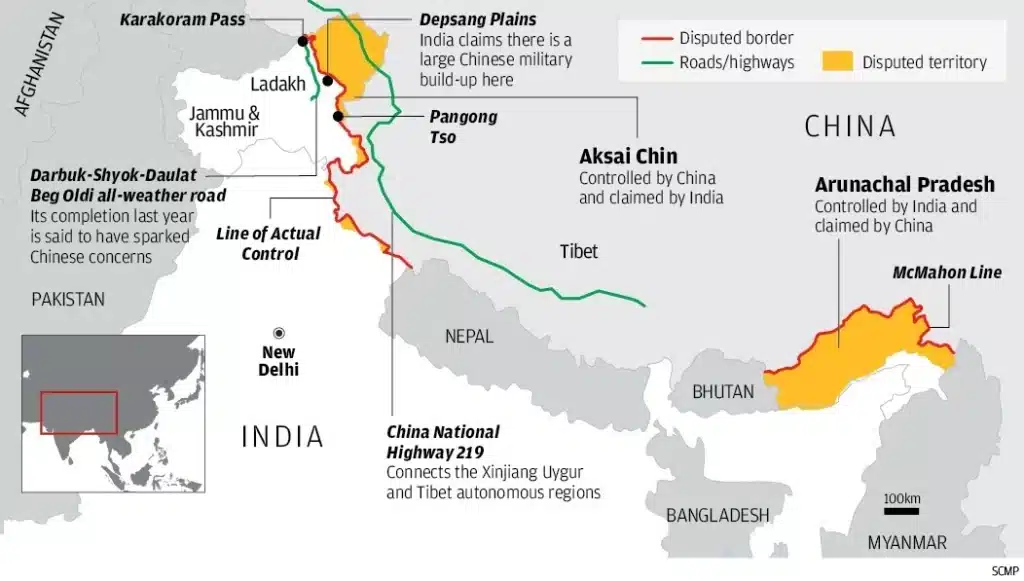
- Western Sector
- India and China share a 2152-kilometre-long border in the western sector. It is located between the Indian states of Jammu and Kashmir and the Chinese province of Xinjiang.
- There is a territorial dispute in this sector over Aksai Chin. In 1962, both countries went to war over the disputed territory of Aksai Chin. It is claimed by India to be part of Kashmir, while China claims it to be part of Xinjiang.
- The dispute over Aksai Chin can be traced back to the British Empire’s failure to establish a clear legal border between China and its Indian colony. During British rule in India, two proposed borders between India and China were Johnson’s Line and McDonald Line.
- The Johnson Line (proposed in 1865) places Aksai Chin in Jammu and Kashmir, under Indian control, whereas the McDonald Line (proposed in 1893) places it under Chinese control.
- India considers the Johnson Line to be the correct, rightful national border with China, whereas China considers the McDonald Line to be the correct border with India.
- At the moment, the Line of Actual Control (LAC) separates Indian areas of Jammu and Kashmir from Aksai Chin. It runs parallel to the Chinese Aksai Chin claim line.
- Middle Sector
- In this sector, India and China share a 625-kilometre-long border that runs from Ladakh to Nepal.
- In this sector, the states of Himachal Pradesh and Uttarakhand touch the border with Tibet (China). In this area, there is little disagreement between the two sides.
- Eastern Sector
- India and China share a 1,140-kilometre-long border in this sector. It stretches from Bhutan’s eastern border to a point near the Talu Pass, which connects Tibet, India, and Myanmar. This boundary line is known as the McMahon Line.
- Except where the Kemang, Subansiri, Dihang, and Lohit rivers break through the Himalayan crest of the northern Brahmaputra watershed, the boundary was established along the Himalayan crest of that watershed.
- The British-India government convened a tripartite conference in 1913, at which the boundary between India and Tibet was formalized following a discussion between Indians and Tibetans.
- The Indo-Tibetan boundary was delineated as a result of the adoption of a Convention.
- China considers the McMahon Line to be illegal and unacceptable, claiming that Tibetan representatives who signed the 1914 Shimla Convention, which delineated the McMahon Line on the map, lacked the legal authority to do so.
Johnson Line Vs McDonald Line
- Even on the Johnson and McDonald lines, which separate the two countries’ territories, the two countries have maintained their respective positions.
- The Johnson Line- India’s accepted demarcation: designates Aksai Chin as Indian territory.
- The McDonald Line- China’s position: designates Aksai Chin as Chinese territory.
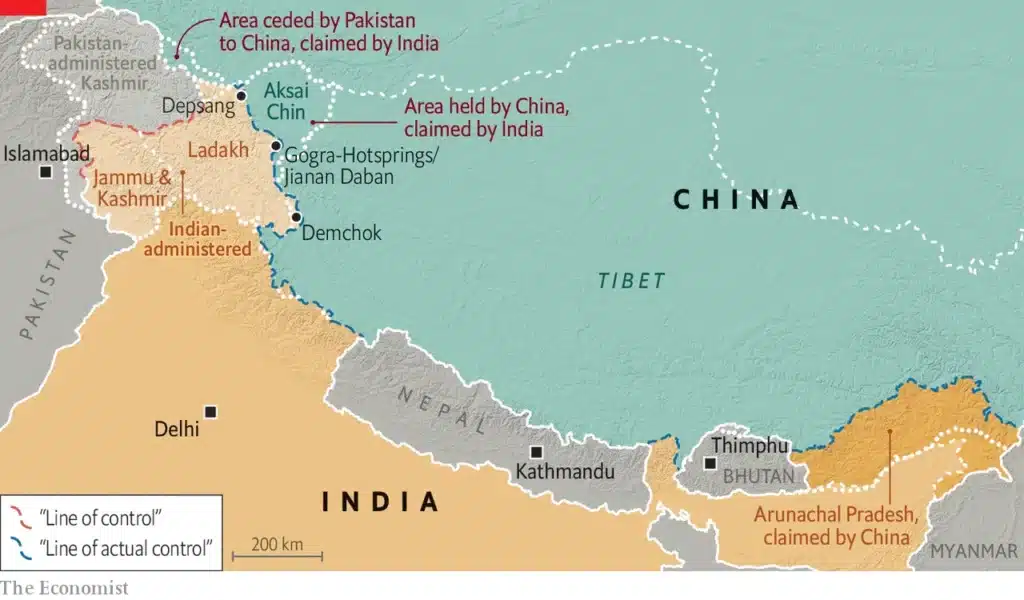
String of Pearls
String of pearls, in geo-strategic parlance, refers to Chinese military and commercial facilities and relationships, in and around the Strait of Malacca, Sri Lanka (Hambantota port), Pakistan (Gwadar port), the Maldives, the Strait of Hormuz and Somalia. It also includes Bangladesh (Chittagong) and Myanmar (Sittwe port) in Chinese strategy.
The Strait of Malacca is key for China’s energy requirements. About 80 per cent of China’s fuel from the Middle East passes through this. China has developed assets in Myanmar and Sri Lanka and has been pushing Bangladesh to allow it to develop a small naval base near Chittagong. The China Pakistan Economic Corridor (CPEC) is developing into a vital geo-strategic and trade asset of China. Therefore, the encircling by China poses a threat to the India’s interest.
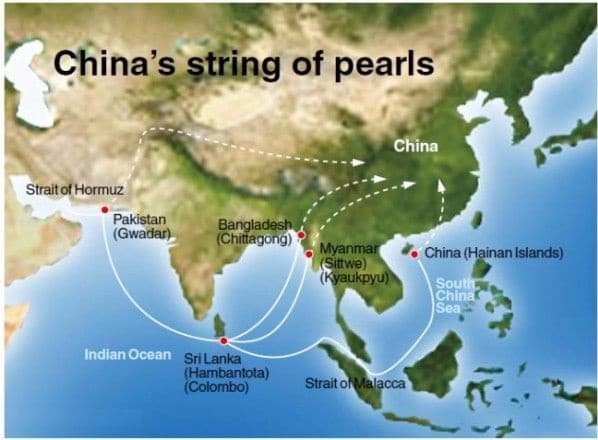
Water Dispute
The Brahmaputra, also known as the Yarlung Tsangpo in Tibet, the Siang/Dihang River in Arunachal Pradesh, and Luit, Dilao in Assam, originates in the Manasarovar Lake region, near the Mount Kailash, flows through South Tibet, India, and Bangladesh. It enters India west of Sadiya town in Arunachal Pradesh.
Brahmaputra River water sharing is a major flashpoint between India and China. China has been building dams after dams in the upper reaches of the Brahmaputra which is called Tsangpo in Tibet. India has objected to it, but there has been no formal treaty over sharing of the Brahmaputra river water.
Further, China has not been forthcoming in sharing the details about water level in Brahmaputra, which puts a large tract in the states of Arunachal Pradesh and Assam to the risk of sudden and huge flood. India is now planning to build nearly two dozen dams on the Brahmaputra and its tributaries to deal with the flood problem.

Dalai Lama and Tibet
Tibet had declared independence from China in 1913. China reoccupied Tibet in 1950. A Seventeen Point Agreement was signed and Tibet legally merged with China. India has accepted the merger. Chinese occupation of Tibet was not welcomed by the masses and the kingdom saw an uprising to which China responded with force. The 14th Dalai Lama fled to India in 1959 and Indian government granted him and his followers political asylum.
China accused India of fomenting trouble in Tibet. The Dalai Lama formed a Tibetan government in exile, which still functions without any real authority over the people. Protests are often staged by Tibetans against China in India and many other countries. China objects to the Dalai Lama’s free movement in India and abroad in general and his recent visit to Arunachal Pradesh in particular.
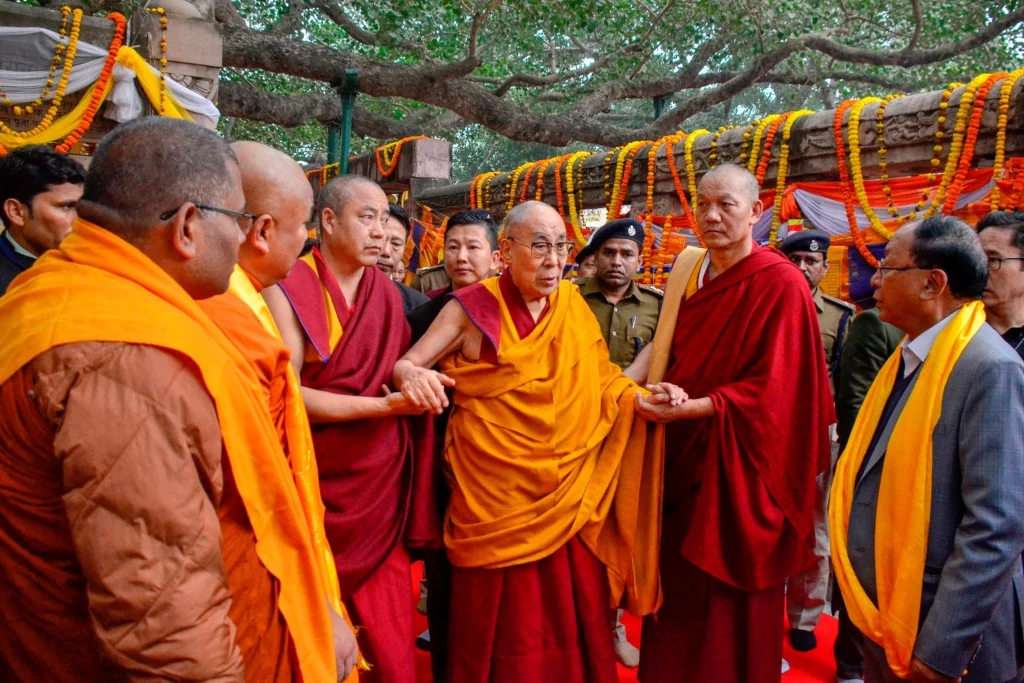
Arunachal Pradesh and Stapled Visa
China began the practice of issuing stapled visas to residents of Arunachal Pradesh and Jammu and Kashmir. India has lodged strong protest against China saying, by resorting to these tactics Beijing is questioning India’s sovereignty and territorial integrity. In 2011, China stopped the practice of issuing stapled visa for the residents of Jammu and Kashmir. But it continues for people living in Arunachal Pradesh.
Bhutan and Nepal
China has been critical of India’s role in and its relationship with Bhutan and Nepal. India has a long tradition of cultural and trade exchanges with both Nepal and Bhutan. India has a security arrangement with Bhutan for protection of its borders under treaty of friendship, 1949 (revised in 2007).
Nepal has been dependent on India for all practical economic purposes. India facilitates its external trade. Only recently Nepal signed a pact with China ending Kathmandu’s singular dependence on India for foreign trade. Now and then, both have been playing “China Card” against India, especially Nepal to ensure its demands are met.
Belt and Road Initiative
The One Belt One Road (OBOR) initiative focuses on improving connectivity and cooperation among Asian countries, Africa, China and Europe. The emphasis is on enhancing land as well as maritime routes.
The initiative is significant for China since it aims to boost domestic growth in the country and to augment its stature at global level. Experts have noted that OBOR is also a part of China’s grand strategy for economic diplomacy as well as flexing its economic might to increase global footprint in unchartered region of economic importance. Such Geo-economic calculus will bring externalities in terms of “boosted Geopolitical footprint”.
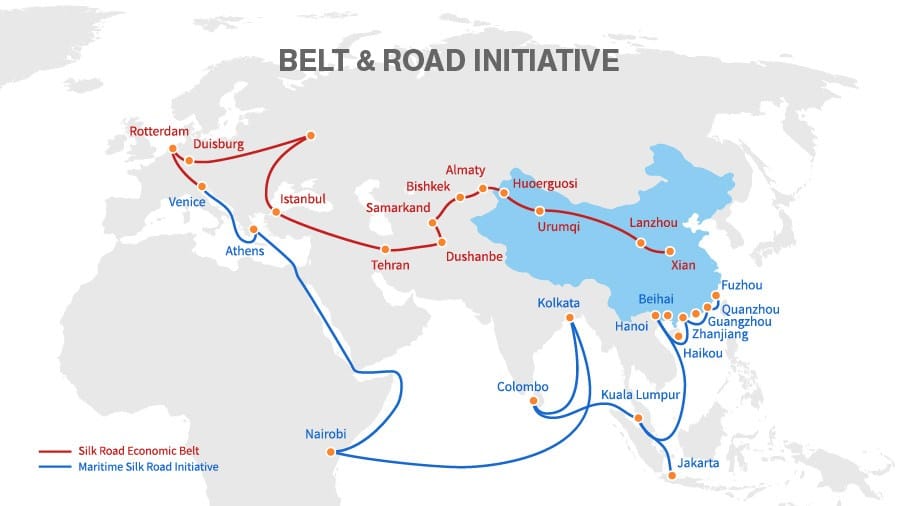
Reasons for India’s Opposition
- China-Pakistan Economic Corridor (CPEC) which is a part of OBOR, passes through Indian territory Gilgit and Baltistan region (PoK) undermining Indian sovereignty.
- The initiative lacks transparency in its objectives and thus raises doubt.
- India also has raised concerns about environmental damage and Chinese “credit imperialism” (by giving predatory loans) which will undermine the sovereignty of dependent countries.
India’s Membership of OBOR
- There are divided views over it. Some say that it would be a missed opportunity because such infrastructure oriented projects will bring a lot of positive externalities at a time when India is starved of appropriate funds to put right infrastructure in its coastal areas and general maritime infrastructure.
- C. Rajamohan, a strategic geopolitical commentator, says that India must show “economic common sense” to grab the opportunity besides raising the needed concern (of CPEC only) rather than outrightly rejecting the project. He further says that despite India’s resentment, China will move ahead seeing its acceptability by not only many big countries, but also by India’s neighbouring ones.
- Nevertheless, India must raise concern at various platforms through formal as well as informal channel to not let China set a wrong precedent at the cost of India’s sovereignty in collusion with Pakistan.
- India’s concerns on the BRI could be resolved if Delhi and Beijing move from the discussion of the BRI as a single grand initiative, to specific connectivity projects. Also, China should be prepared to address Delhi’s concerns on sovereignty and sustainability.
China-Pakistan Nexus
- China’s relationship with Pakistan has been a major source of concern in India. Its role in strengthening Pakistan’s conventional, missile and nuclear capabilities, and tacit approval of Pakistan sponsored terrorist activity like blocking the UN bid to declare Masood Azhar an International Terrorist are especially problematic.
- CPEC: India is opposed to China’s Belt and Road Initiative as a strand of it – CPEC – runs through Gilgit and Baltistan, which is an Indian territory of Kashmir, illegally occupied by Pakistan. India has also stayed away from an international summit organized by China in Beijing (BRI-Belt Road Initiative Summit). China was given the authority to manage Gwadar port of Pakistan near Iran border for next 40 years. The naval forces of China and Pakistan are holding joint exercises, raising concerns for India.
- Masood Azhar: China has repeatedly blocked India’s move to put a ban on Pakistan based Jaish-e-Mohammed chief and Pathankot terror attack mastermind Masood Azhar as a global terrorist by the UN.
- Also, China and Pakistan are opposed to India’s membership of Nuclear Suppliers Group (NSG) and permanent membership of United Nations Security Council (UNSC). In this context, Pakistan is opposing India’s UNSC bid being a member of Coffee Club (Uniting for consensus against G4 bid for UNSC permanent membership).
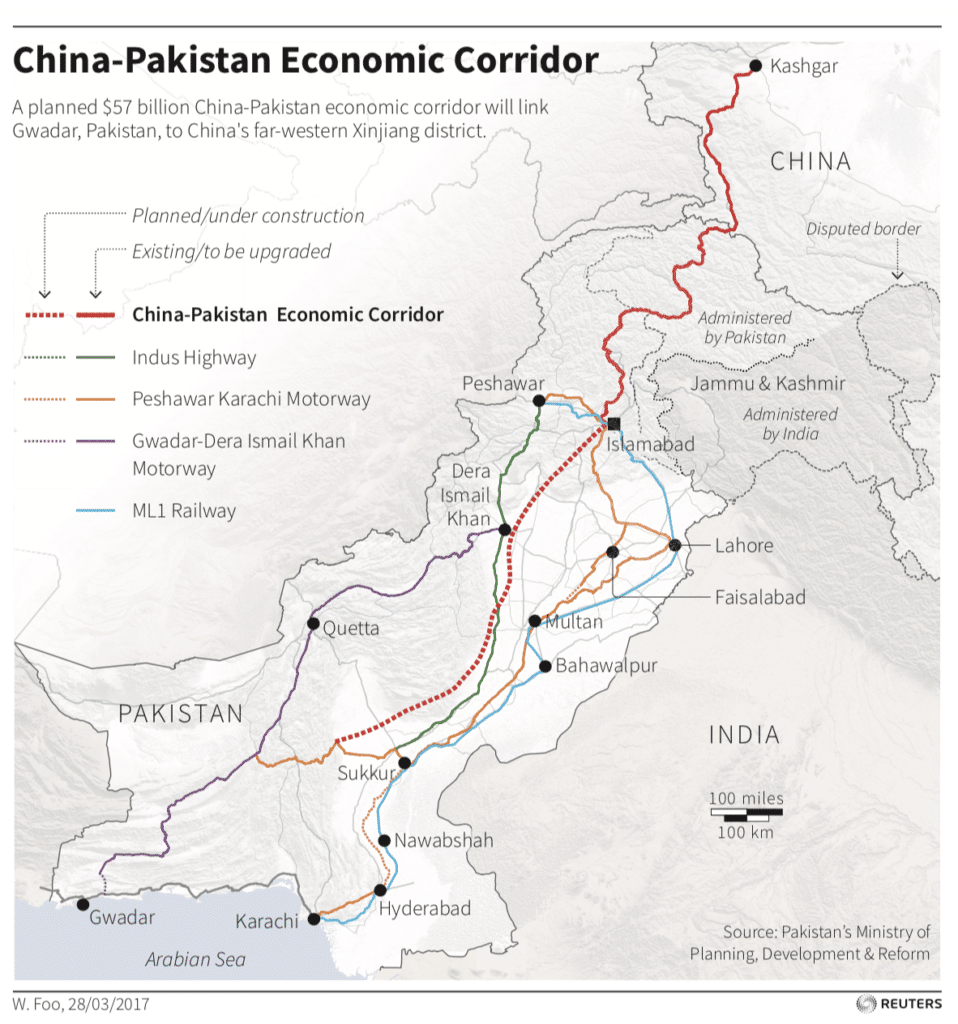
India-USA and its Allies Closeness
- Malabar Exercise: China has raised concern about the trilateral naval exercise between India-US-Japan saying it is targeted against China. The main aim of the exercise is to address the shared threats to maritime security in the Indo-Asia Pacific.
- Revival of Quad: A regional coalition, the quadrilateral formation includes Japan, India, the United States and Australia. In these intervening years, the world has gone through a recession, the US has lost some of its global power and influence, China has grown its military and economic might, and a resurgent India has aimed to position itself as a counterweight to China in Asia. The revival of Quad, thus, is the result of China’s assertiveness, its ambitious agenda and its increasing ‘cartographic aggression’ (habit of getting in conflict by tinkering with its map as ‘9 dash line’ , conflicts in South China Seas for territorial claim over Spratly and Paracel Islands, Senkaku Island with Japan and Scarborough shoal with Philippines). Formation of Quad brings into focus the maintenance of the ‘rules based order ‘ in the Indo-Pacific region.
- South China Sea: India and USA share a similar view of freedom of navigation in Ocean. In 2015, during former President Obama’s visit, the joint statement noted concern about the South China Sea while previous such statements had exhorted freedom of navigation. In general terms, India’s willingness to mention the sea by name indicated a new willingness to confront China.
- Pivot Asia: In the pursuit of “Rebalancing” the Asia-pacific region to sustain its pre-eminence, the USA has been found to be bringing India in its design to counter China. The recent increasing closeness between US-India is evident in LEMOA (Logistic Exchange Memorandum of Agreement), more defence deals and India’s membership of Missile Technology Control Regime (MTCR) plus strong support for NSG membership after Indo-US Civil Nuclear Deal.
- However, can India afford to antagonize a neighbour with which it is organically connected? As it is rightly said that one can choose friends but not neighbours, India must be making all efforts to contain China wherever possible, in alliance with similar minded countries as Japan, USA, etc., as well as engage China in economic and cultural arena (Congagement Policy).
Indian Ocean Region
China’s increasing interest in operating in the Indian Ocean has been a concern to India because India has traditionally considered the region its backyard.
- Setting up of China’s first military outpost in Djibouti underscores its growing political influence in Indian Ocean Region which embeds it into the geopolitics of the Indian Ocean.
- China Merchant Port Holdings (CMPH), has acquired a 70 percent stake in Hambantota Port. Sri Lanka has said it will not allow the docking of Chinese warships and submarines at Hambantota, but this is unlikely to endure in the long run.
- Bangladesh has avoided signing a longterm comprehensive Defence pact with India, presumably because much of its military equipment (including strategic platforms such as submarines) is sourced from China. Due to China’s economic clout, Bangladesh has decided to give majority stakes at Payra Port to China Harbour Engineering Company Limited (CHEC).
- In Myanmar, China is looking to take a stake up to 85 percent in a strategically important sea port in Kyaukpyu and even pushing for preferential access to port facilities. China has already built an oil and gas pipeline spanning from Kyaukpyu to Kunming, in the province of Yunnan.
- China has also sought to transform its navy into a blue water navy by acquiring capabilities which allow it to project power across oceans.

Economic
- Trade Deficit: The overall trade deficit has gone from $28 billion in 2011 to $ 75 billion in 2022 against India.
- Anti-Dumping: Dumping is an unfair trade practice of exporting goods to another country at a price lesser than what is paid in the exporting nation or their normal production cost, thereby distorting international trade and causing injury to the domestic manufacturers of the goods in the importing country. India’s manufacturers in steel, chemicals, electrical and electronics sectors are being “severely hurt” by “unfairly low-priced” imports from China causing losses to the local manufacturers due to dumping.
- Market Economy Status (MES): Once China is granted MES, it will severely limit India’s ability to resort to antidumping as the authorities (DGAD) will have to accept the production costs and selling price in China as the benchmark. It will, in turn, mean lesser chances of antidumping duties being imposed or lesser anti-dumping duties even if they are imposed.
- China’s highly restrictive regime for inward investment: India is disadvantaged by a regime in which Chinese firms can freely invest abroad while China’s own markets remain quite closed. In India, there have also been complaints about market access in China and the treatment of Indian labor there, concern about Chinese investment in “strategic” sectors in India, accusations about visa abuses by Chinese companies and restrictions on Chinese labor.
- Cyber Attack: Reports of cyber-attacks on Indian government and military networks—allegedly emanating from China have also been a concern.
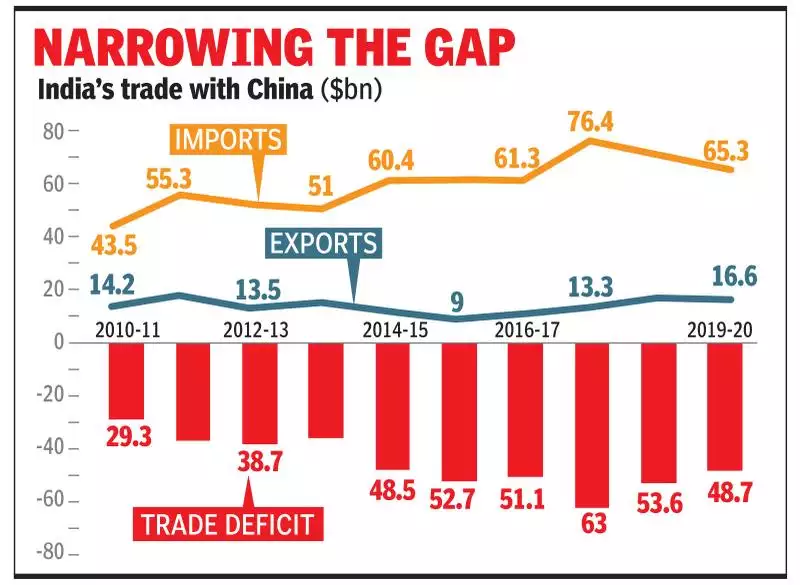
International Fora
- Nuclear Suppliers Group (NSG): The NSG controls the global exports of nuclear technology and material to ensure that atomic energy is used only for peaceful purposes. China has consistently blocked India’s bid, pointing to the need for devolving universally applicable membership criteria for all countries that have not signed the NPT, but had become nuclear weapon states. India has underscored that NPT membership is not essential for joining the NSG, as was in the case with France, which became a member of the NSG without signing the NPT.
- UNSC: China is disinclined to unilaterally support India for a permanent slot, preferring instead a collective consensus-based approach, which would be part of a larger “package” of UNSC reforms. China has a special relationship with Pakistan which is staunchly opposed to India’s candidature.
South China Sea
- China claims 90 percent of the energy-rich South China Sea through which trade worth $5 trillion passes annually. Its claims are contested by Brunei, Malaysia, Taiwan, the Philippines and Vietnam.
- China-Philippines UNCLOS: The Hague Permanent Court of Arbitration backed the Philippines on the
disputed waters of the South China Sea, ruling that rocky outcrops claimed by China cannot be used as the basis of territorial claims. The tribunal found that China had violated the Philippines’ sovereign rights by interfering with its fishing and petroleum exploration and by constructing artificial islands. The tribunal concluded that there was no legal basis for China to claim historic rights to resources in the sea areas falling within the ‘nine-dash line’. - China has rejected the Tribunal’s verdict, a decision which has serious real-world implications for the international order. India’s position is that it supports freedom of navigation and over-flight, and unimpeded commerce, based on the principles of international law, particularly UNCLOS. Freedom of Navigation and stability in South China Sea region is of strategic economic importance for India.
Doklam Standoff
Doklam is the Bhutanese name of the region which is recognized by India as Doka La. China claims it as a part of its Donglang region. At present, China and Bhutan are engaged in talks over the resolution of the area. However, Bhutan has no diplomatic ties with China and it is supported militarily and diplomatically by India.

The Issue
The land in question spans 269 square kilometers on a sparsely populated plateau in western Bhutan. Bhutan said the road China has been building would run from the town of Dokola to the Bhutanese army camp at Zompelri. Bhutan called it a “direct violation” of agreements reached in 1988 and 1998 to maintain peace and refrain from unilateral action in the area pending a final border settlement.
Reasons for India’s Involvement
- The 2007 India-Bhutan Friendship Treaty states that the two countries “shall cooperate closely with each other on issues relating to their national interests.” The Royal Bhutan Army tried to intervene construction by China but they were pushed back. Hence, they approached the Indian troops for help. The latter then moved down the ridge and obstructed the construction work, leading to the standoff.
- Any change at Doklam would “represent a significant change of status quo with serious security implications for India.”
- India says that both New Delhi and Beijing had agreed in 2012 that trijunction points between India, China and third countries would be finalised in consultation with all the countries concerned. China’s attempt to build a road in the region, hence, is a unilateral action in violation of the 2012 understanding.
Significance of Region to India
- Doklam is critical as it brings China even closer to the India border in a vulnerable location towards the direction of the 27 km-long Siliguri Corridor or ‘chicken ‘s neck‘ that links the northeastern states to the rest of India.
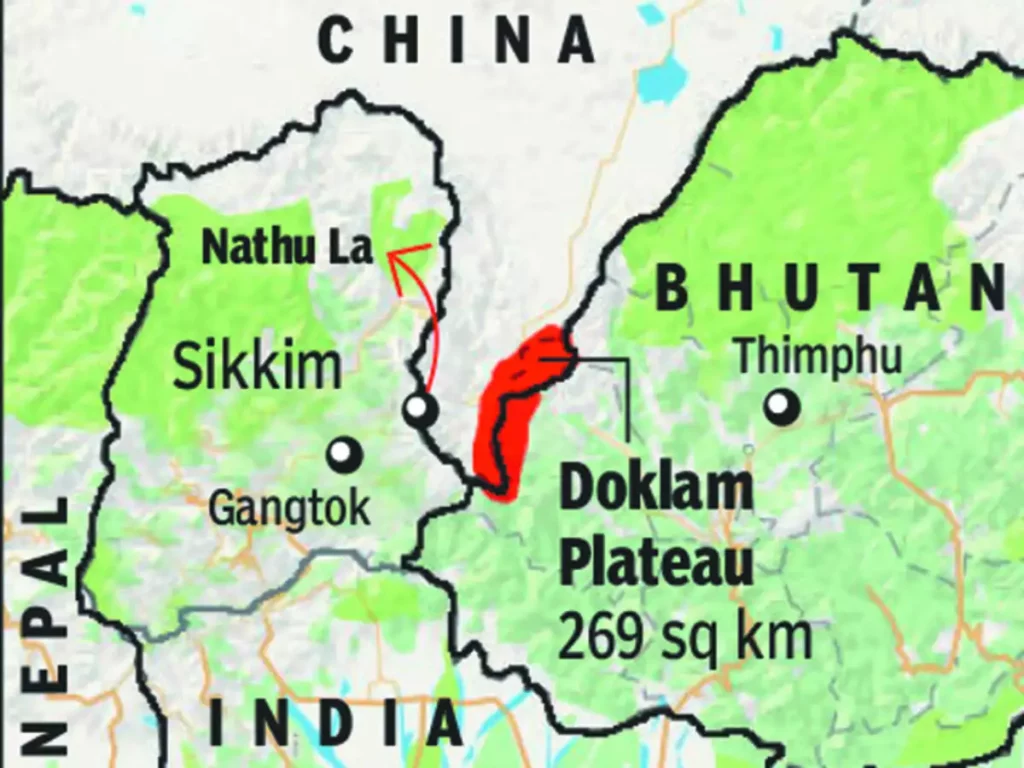
Significance of Doklam Conflict
- India: The US, the UK and Japan – three major global players went ahead to state that the standoff must be resolved through dialogue and bilaterally. The Doklam episode is a diplomatic achievement of India and a successful effort by India to block China’s Himalayan strategy.
- India’s Neighbour: It aiso sends a strong message to India’s neighbours that India can stand for them in the times of crisis. Sri Lanka and Bangladesh may rethink their Chinese policy and come out stronger in dealing with China.
- The Doklam standoff holds significance for the larger boundary dispute between India and China, and suggests a hardening Chinese position on interpreting past agreements.
Galwan Valley Standoff
- In a remote Himalayan valley in mid-June 2020, Chinese and Indian troops faced each other armed only with sticks and rocks. By the end of the battle in the Galwan Valley, at least 20 Indian soldiers had been killed and 76 had been injured.
- It was the deadliest clash between the two militaries on their high-altitude border in decades, sparking a frenzy of diplomatic activity to try to defuse tensions.
- On June 15, clashes occurred at more than 4,000 metres (14,000 feet) above sea level in an area between Indian-controlled Ladakh and Chinese-controlled Aksai Chin, but it is unclear what caused them.
- The deadly clash occurred after another clash on May 5, and during both sides’ attempts to de-escalate the subsequent six-week standoff.
- Because of a 1996 agreement signed by the two sides to build trust and begin to resolve the border issue, the troops did not have guns. Instead, the soldiers used fists, sticks, and rocks to fight.
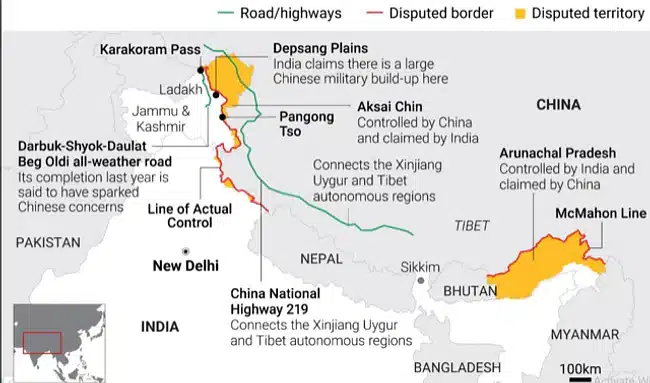
What is the issue?
- The Indian and Chinese armies are engaged in the standoff in Pangong Tso, Galwan Valley, Demchok and Daulat Beg Oldie in eastern Ladakh.
- A sizable number of Chinese Army personnel even transgressed into the Indian side of the de-facto border in several areas including Pangong Tso.
- The actions on the northern bank of Pangong Tso are not just for territorial gains on land, but enhanced domination of the resource-rich lake.
- The stand-off at Ladakh’s Galwan Valley has escalated in 2020 due to the infrastructure projects that India has undertaken in the recent years. India is building a strategic road through the Galwan Valley – close to China – connecting the region to an airstrip.
- China is opposed to any Indian construction in the area. In 1962, a stand-off in the Galwan area was one of the biggest flashpoints of the 1962 war.
- The border, or Line of Actual Control, is not demarcated, and China and India have differing ideas of where it should be located, leading to regular border “transgressions.” Often these don’t escalate tensions; a serious border standoff like the current one is less frequent, though this is the fourth since 2013.
- Both countries’ troops have patrolled this region for decades, as the contested 2,200-mile border is a long-standing subject of competing claims and tensions, including a brief war in 1962.
- Reasons: The violent clash happened when the Chinese side departed from the consensus to respect the LAC and attempted to unilaterally change the status quo.
- It is part of China’s ‘nibble and negotiate policy’. Their aim is to ensure that India does not build infrastructure along the LAC. It is their way of attaining a political goal with military might, while gaining more territory in the process.
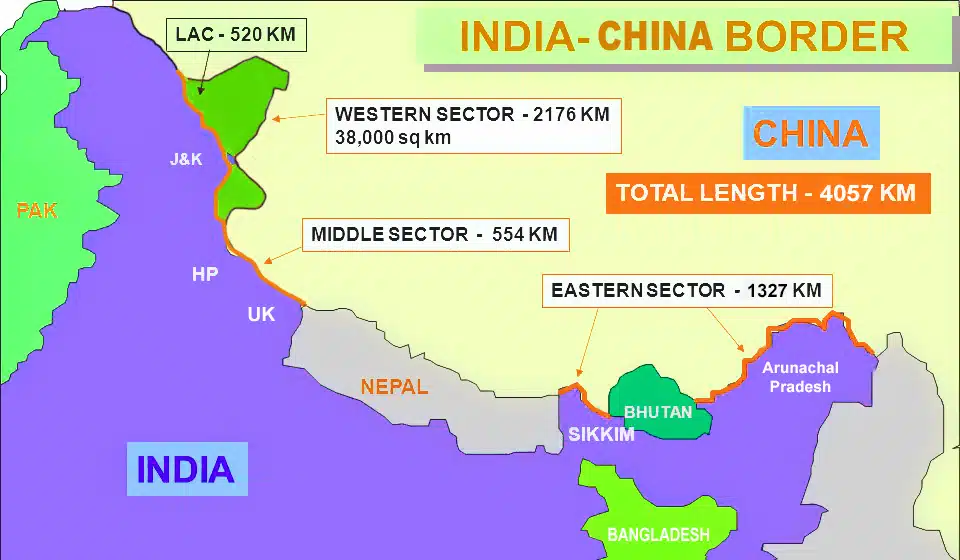
Sino-lndia Competition
India and China are two fastest growing major economies of the world. Despite tumultuous period (2008 onward) of global slowdown, they have shown resilience with 6-7% of sustained growth. This unleashed confidence has made them to explore world as in Africa, Latin America, Middle East, South Asia, South East Asia, and Central Asia etc . , for investment, trade, and socioeconomic development activities.
Whereas china is emboldened with its Foreign Exchange Reserve, its manufacturing might, high technology and decisive policy, India is confident of its “demographic dividend”, democratic good will, low labour cost, proven software skill, burgeoning service sector ‘s success, etc. With these wherewithal, both are alluring different regions to strengthen their investment base .
Africa, so far, has been mainly dominated by the USA and European Union for trade and investment, but now the Euro zone crisis and global slowdown have given space for the Asian Giants to delve into. Though China, with its more than $200 billion trade (2014) is far ahead of India’s $70 billion for the same, the very exploitative and predatory business practices of China has made Africans realize India’s good gesture, good intention and its strong empathetic legacy in the continent.
The very strong Indian Diaspora, Gandhian connect, century old connect plus recent compassionate outlook of Indian establishment (ITEC, Wellness tourism etc.) has made India a favourable partner. Asia-Africa Growth Corridor (AAGC) is a recent development initiative by India and Japan in the continent for economic cooperation. The AAGC would consist of four main components:
- (i) Development and cooperation projects,
- (ii) Quality infrastructure and institutional connectivity,
- (iii) Capacity and skill enhancement and
- (iv) People-to-people partnerships.
It’s definitely an initiative to sustain India’s hold in Indian ocean when onslaught of Chinese-led OBOR is on the way.
Similarly, the Sino-lndia competition in the Middle East can be seen in terms of allying with Iran for putting Infrastructure and energy cooperation. India too is pushing hard for Chabahar port in Iran and International North-South Transport Corridor (INSTC) in the region and beyond connecting Central Asia.
In south East Asia, India has revisioned its “Look East Policy” by making it ‘Act East’ Policy. It is to add more vigor, energy and dynamism in the relationship to tap the region. The close relationship with Vietnam and combined patrolling and oil/gas exploration in the South China Sea has annoyed China. India is also making efforts to establish good relations with, Taiwan, Mongolia, Japan, South Korea and others in the region of East Asia, so that there would be resilient hedge against unholy nexus of China Pakistan against India.
The competition is everywhere from exploiting resources in the Afghanistan (Iron ore, copper) to filling the void there to be left by the USA allied forces. The very implicit “security dilemma” in each sphere has made both countries anxious. The global development in terms of need to rearrange global governance either by restructuring global institutions or facing the challenges arising like climate change, nuclear arm race, rush to exploit new findings, etc., have made both giants to feel affected and hence all way effort to earn brownie points as each move determines one’s strength.
However, even a moderate improvement in India’s ability to deliver projects on time can help it reduce delays and gain a leg up on China if it offers assistance without the debt and political intimidation that now comes with Chinese aid.
Three major developments of year 2017 in terms of Doklam military standoff, India’s boycott of BRI initiative and Quadrilateral security dialogue (Quad) reflect the uneasiness in Beijing and Delhi vis-a-vis growing competition between them.
The Wuhan Summit in April 2018 was a useful, timely and necessary step after these developments.
Way Forward:
Managing relationship with China has become the biggest test for Indian foreign policy
- Trust deficit is a critical issue in Sino-Indian bilateral relations. In order to solve this problem, track II diplomacy can play a more active role. For e.g. BCIM (Bangladesh–China–India–Myanmar) economic corridor is an outcome of track II dialogue.
- There is a need to control negative publicity in the relationship. Deeper engagements between the media persons of the two countries can help in improving image of the two countries.
- Improvement of the India-China relations require rational voices, A comprehensive and substantial study of each other’s national and social conditions is need to be done by scholars to strengthen cooperation.
- Cultural industry, including tourism, entertainment, publications, internet service sectors, needs to be targeted to reduce the trade deficit.
- There is need to increase the frequency of talks at highest levels multilateral meets such as East Asia Summit (EAS), the Shanghai Cooperation Organisation (SCO), Conference on Interaction and Confidence-Building Measures in Asia (CICA), BRICS and G-20.
- India and China should seek an early settlement of the border issue, before the final settlement of the boundary question is reached we should jointly maintain peace and tranquillity in the border areas.
- Both nations need to master the four keys of:
- Leading: It means to reach consensus and guide the direction of the development of bilateral relations under the guidance of leaders from both nations.
- Transmitting: It means to transmit the leaders’ consensus to all levels and translate it into tangible cooperation and outcomes.
- Shaping: It means to go beyond the mode of managing differences, shape bilateral relations actively and accumulate positive momentum.
- Integrating: It means to strengthen exchanges and cooperation, promote convergence of interests and achieve common development.
Conclusion
China and India must transcend the bilateral dimension of their ties for stability in Asia and the world. Enhancing confidence-building measures and an early settlement of the boundary issue is vital for the two nations. The two rising Asian powers are helping shape a new distribution of global power, as demonstrated not just by their growing prominence within the machinery of multilateral economic and security diplomacy (both, for example, are members of the G20), but also by the ardour with which they are courted by other international actors. So, they must rise to the occasion for betterment of world in general and developing world in particular which they themselves comprise maximally.

Thanks for your effort, this article is very helpful.
Best content very helpful, thankyou so much
can i get pdf of it ?
https://store.lotusarise.com/product/international-relations-notes-for-upsc/